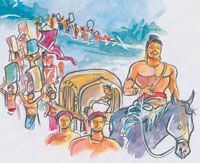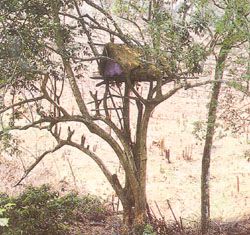|
King
Mahanaga, first king of Ruhuna Mahanaga, who
patronized agriculture was building and repairing major irrigation
works. Once he started building a new tank named Walas-Wewa. 'Thupawansa'
refers to it as 'Sarasa Wewa'. When Mahanaga was spending almost
the whole day at this site, the young prince preferred to be with
him. The queen in the meantime, was planning to kill Mahanaga. This is what the wicked queen planned. She got a basket of mangoes, selected the best mango and injected poison into it. She kept that mango right on top and through a servant, sent the basket to Mahanaga, who was supervising the work at the tank. The servant was ignorant of the queen's plan. As the mangoes were delivered, it was Devanampiya Tissa's son, who accepted it. He ate the mango that was right on top. This brought about the death of the young prince. Mahanaga was shocked and frightened about what had happened. Later on, he got to know the truth of the matter. He thought it was not safe to live in Anuradhapura. He assembled his supporters and said, "If I continue to live here, I'm only inviting death. I have decided to go to another province. I'm not asking anyone to join me, but those who wish to, could follow me". All the people who were gathered there, wanted to accompany Mahanaga. Maha-naga valued life more than kingship and collected whatever was needed for the journey. His wife was pregnant at the time. Although with difficulty, he had to take her. Devanampiya Tissa and Mahanaga, the two brothers, loved each other so much that the king would never have allowed Mahanaga to leave Anuradhapura. Hence, Mahanaga never told his brother that he was quitting his birthplace. The people who consented to join Mahanaga were also sad to leave their homes and all that was closely associated with their lives. But it had to be done. As agreed, all of them left the city of Anuradhapura secretly and marched to the south. As they were passing the village 'Yatalagama', Mahanaga's queen was in labour pain. There was no house close-by. The only building they could see was a temple. Mahanaga managed to take the queen to the temple. The priests,
having arranged a suitable place for the queen, moved away. Before
long, the queen delivered a baby boy. In naming the boy, Mahanaga
took Tissa from his brother's name and Yatala from the place where
he was born, and named the boy 'Yatala-Tissa'. After a few days,
the queen recovered and they could resume their journey. They reached
'Ruhuna'. Mahanaga became king of the Southern Province, with Magama
as its capital. 'Thupavamsa' differs here by mentioning that there
was a ruler already in the south and Mahanaga killed him to become
king. However that may be, it is Mahanaga, who developed the south by improving agriculture. He was responsible for raising a peaceful and prosperous people in the Southern Province. He was succeeded by Yatala-Tissa, who was able to rule the province righteously. By the time Yatala-Tissa's son Gothabhaya became the king of the south, the province was well developed. After Gothabhaya, his son Kavan-Tissa came to the throne.
A hut is built
at a central spot and the head of the family spends the night in
the hut scaring the wild animals away, particularly when the plants
begin to bear. Water is the
most essential thing in the village. Each household has a well dug
in the garden. Sometimes there would be a common well used for both
bathing and taking water for drinking purpose. Usually the womenfolk
bathe in the well while men prefer to take a dip in a nearby stream.
The well became the meeting place for women where village gossip
is discussed. Access to the village is either by footpaths or cart tracks. Often these are through jungle where the wild animals roam in search of food. The villager is not scared of them. He considers them as part of their life and follows a policy of live and let live. Sometimes he would hunt a deer or a hare for flesh but on the whole, he leaves the animals alone. He would sense if a wild animal is blocking his path or is in the vicinity. Then he would avoid the animal by taking a different route or wait a while till the animal moved away. The houses were
built in the natural setting. They were simple homes. Following
traditional practice, they were wattle and daub (warichchi saha
mati) wall houses thatched with cadjan or illuk grass. Clay is used
for the floor. Cow dung is generally applied as a top layer. There would
be a front door to enter the house. In front is an open verandah
where there would be a bed. Visitors usually sit on the bed, which
is used by the male to sleep at night. The wife and children sleep
on mats inside the house. The kitchen
with an open hearth (lipa) is built separately behind the house.
A reed platform (atuva) is hung over the hearth at a height of four
to five feet. In addition to pots and pans, paddy and other grains
and dry fish are kept on it. The well-to-do villager would build
a paddy barn ('bissa') outside the house where paddy is stored after
the harvesting. As the family
grew and the older children got married, each would be given a block
of land to build a house. Usually it's the sons who lived close
to the parents having got married and brought the wives either from
the same village itself or a nearby village. The sons would continue
to help the parents in tilling the land or preparing the paddy fields.
Married daughters would shift to the husband's home. In a village,
one's kith and kin live in close proximity within a 'hoo handa'
(the distance when someone hooting can be heard). Thus a 'gammana'
would appear with common facilities being built up. The 'vedarala'
(physician) is an important personality with the villagers depending
on him to cure their illnesses. It's only if he is unable to cure
that the patient would be taken first to a government dispensary
a few miles away or to the hospital which may be quite far away.
The 'kattadiya'
(exorcist) also has a role to play just as the 'sastrakaraya' (astrologer)
whose main job would be to prepare horoscopes for the newborns according
to the astrological readings. He will also indicate the auspicious
times for numerous activities ranging from the first meal being
given to an infant to starting to build a house or preparing the
land to cultivate. Then there are the 'kammalkaraya' (blacksmith) and the 'vadurala' (carpenter). They both come in handy to get things turned out for their agricultural work and also household use. They all form an integral part of the village society. |
||||
Copyright © 2001 Wijeya Newspapers
Ltd. All rights reserved. |

